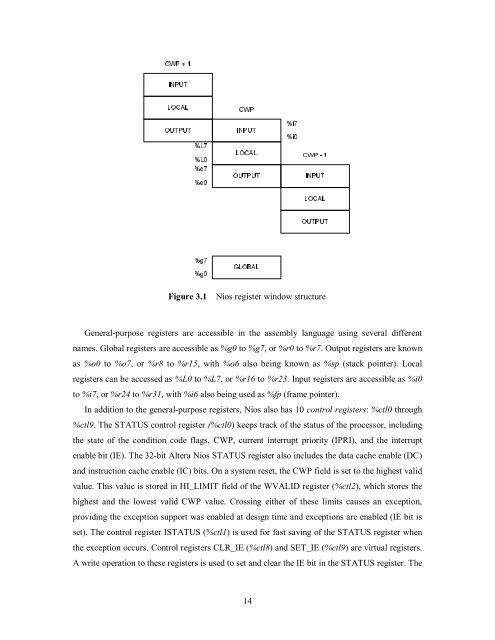Soft-Core Processor Design - CiteSeer
Soft-Core Processor Design - CiteSeer
Soft-Core Processor Design - CiteSeer
You also want an ePaper? Increase the reach of your titles
YUMPU automatically turns print PDFs into web optimized ePapers that Google loves.
�¦��¥���¥<br />
� �§¥�¨��<br />
��§©�¦£ �<br />
§ ¨��©¥�¨��<br />
� ���<br />
�����<br />
� � ¢<br />
����¢<br />
�����<br />
����¢<br />
General-purpose registers are accessible in the assembly language using several different<br />
names. Global registers are accessible as %g0 to %g7, or %r0 to %r7. Output registers are known<br />
as %o0 to %o7, or %r8 to %r15, with %o6 also being known as %sp (stack pointer). Local<br />
registers can be accessed as %L0 to %L7, or %r16 to %r23. Input registers are accessible as %i0<br />
to %i7, or %r24 to %r31, with %i6 also being used as %fp (frame pointer).<br />
�¦��¥<br />
� �§¥�¨��<br />
��§©�¨£©�<br />
§ ¨��¦¥�¨��<br />
��§¢¡¤£©�<br />
In addition to the general-purpose registers, Nios also has 10 control registers: %ctl0 through<br />
%ctl9. The STATUS control register (%ctl0) keeps track of the status of the processor, including<br />
the state of the condition code flags, CWP, current interrupt priority (IPRI), and the interrupt<br />
enable bit (IE). The 32-bit Altera Nios STATUS register also includes the data cache enable (DC)<br />
and instruction cache enable (IC) bits. On a system reset, the CWP field is set to the highest valid<br />
value. This value is stored in HI_LIMIT field of the WVALID register (%ctl2), which stores the<br />
highest and the lowest valid CWP value. Crossing either of these limits causes an exception,<br />
providing the exception support was enabled at design time and exceptions are enabled (IE bit is<br />
set). The control register ISTATUS (%ctl1) is used for fast saving of the STATUS register when<br />
the exception occurs. Control registers CLR_IE (%ctl8) and SET_IE (%ctl9) are virtual registers.<br />
A write operation to these registers is used to set and clear the IE bit in the STATUS register. The<br />
14<br />
��� �<br />
��� ¢<br />
�¦��¥���¥<br />
� �§¥�¨��<br />
��§ �¦£©�<br />
§ ¨��¦¥�¨��<br />
Figure 3.1 Nios register window structure














